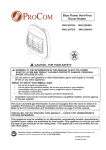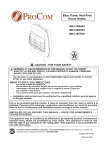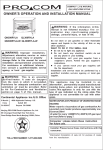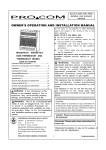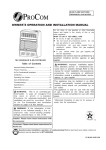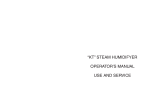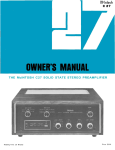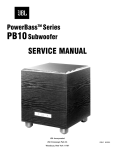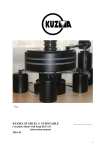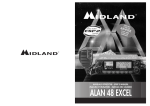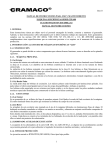Download Procom MN100HPA Product specifications
Transcript
Vent-Free Gas Infrared space Heater MN180TPH ML150TPH MN180HPH ML150HPH MN300TPH ML250TPH MN300HPH ML250HPH CAUTION - FOR YOUR SAFETY WARNING: IF THE INFORMATION IN THIS MANUAL IS NOT FOLLOWED EXACTLY, A FIRE MAY RESULT CAUSING PROPERTY DAMAGE, PERSONAL INJURY, OR LOSS OF LIFE. -- Do not store or use gasoline or other flammable vapors and liquids in vicinity of this or any other appliance. WHAT TO DO IF YOU SMELL GAS Do not try to light any appliance. Do not touch any electrical switch; do not use any phone in your building. Immediately call your gas supplier from a neighbor’s phone. Follow the gas supplier’s instructions. If you cannot reach your gas supplier, call the fire department. -- Installation and service must be performed by a qualified installer, service agency or the gas supplier. This is an unvented gas-fired heater. It uses air (oxygen) from the room in which it is installed. Provisions for adequate combustion and ventilation air must be provided. Refer to Air For Combustion and Ventilation section on page 5 of this manual. INSTALLER: DO NO DISCARD THIS MANUAL – LEAVE FOR HOMEOWNER’S FUTURE REFERENCE This appliance may be installed in an aftermarket, permanently located, manufactured (mobile) home, where not prohibited by local codes. This appliance is only for use with the type of gas indicated on the rating plate. This appliance is not convertible for use with other gases. Questions about installation, operation, or troubleshooting? Before returning to your retailer, call customer service department toll-free at (877)886-5989. PC-MEL110-01D-0708 Printed in China TABLE OF CONTENTS Important Safety Information ..........................................................................................................................3 Air for Combustion & Ventilation ....................................................................................................................5 Product Features .............................................................................................................................................7 Preparing for Installation.................................................................................................................................8 Installation .......................................................................................................................................................11 Operation........................................................................................................................................................14 Product Specifications ...........................................................................................................................17 Troubleshooting ............................................................................................................................................18 Replacement Parts.........................................................................................................................................21 Part lists.........................................................................................................................................................22 WARNING: READ THE INSTALLATION & OPERATION INSTRUCTIONS BEFORE USING THIS APPLIANCE IMPORTANT: Read this owner’s manual carefully and completely before trying to assemble, operate, or service this heater. Improper use of this heater can cause serious injury or death from burns, fire, explosion, and carbon monoxide poisoning. WARNING: Due to high temperatures, the appliance should be located out of traffic and away from furniture and draperies. WARNING: Heater becomes very hot when running . Keep children and adults away from hot surfaces to avoid burns or clothing ignition. Heater will remain hot for a time after shutoff. Allow surfaces to cool before touching. WARNING: Do not place clothing or other flammable material on or near the appliance. Never place any objects in the heater. important SAFETY INFORMATION WARNING: Do not store or use gasoline or other flammable vapors and liquids in the vicinity of this or any other appliance. Installation and service must be performed by a qualified installer, service agency, or local gas supplier. This appliance is only for use with the type of gas indicated on the rating plate. This appliance is not convertible for use with other gases. WARNING: When used without fresh air, heater may give off CARBON MONOXIDE, an odorless, poisonous gas. DO NOT INSTALL HEATER UNTIL ALL NECESSARY PROVISIONS ARE MADE FOR COMBUSTION AND VENTILATION. CONSULT THE WRITTEN INSTRUCTIONS PROVIDED WITH THE HEATER FOR INFORMATION CONCERNING COMBUSTION AND VENTILATION. IN THE ABSENCE OF INSTRUCTIONS. REFER TO THE NATIONAL FUEL GAS CODE. ANSI Z223. 1. SECTION 5.3 OR APPLICABLE LOCAL CODES. This heater is equipped with a PILOT LIGHT SAFETY SYSTEM designed to turn off the heater if not enough fresh air is available. DO NOT TAMPER WITH PILOT LIGHT SAFETY SYSTEM! If heater shuts off, do not relight until you provide fresh air. If heater keeps shutting off have it serviced. Keep burner and control compartment clean. CARBON MONOXIDE POISONING MAY LEAD TO DEATH! Early signs of carbon monoxide poisoning resemble the flu with headache, dizziness and/or nausea. If you have these signs, heater may not be working properly. Get fresh air at once! Have heater serviced. Some people - pregnant women, persons with heart or lung disease, anemia, those under the influence of alcohol, those at high altitude - are more affected by carbon monoxide than others. Natural and Propane/LP Gas Natural and Propane/LP gas are odorless. An odor-producing agent is added to the gas. The odor helps you detect a gas leak. However, the odor added to the gas can fade. Gas may be present even though no odor exists. WARNING: Any change to this heater or its controls can be dangerous. WARNING: Models MN180TPH, MN180HPH, MN300TPH, MN300HPH are equipped for natural gas. Field conversion is not permitted. Models ML150TPH, ML150HPH, ML250TPH, ML250HPH are equipped for propane gas. Field conversion is not permitted. WARNING: Do not use any accessories not approved for use with this heater. WARNING: Carefully supervise young children when they are in the room with the heater. WARNING: Make sure grill guard is in place before running heater. WARNING: Keep the appliance area clear and free from combustible materials, gasoline, and other flammable vapors and liquids. 1. This appliance is for use with only the type of gas indicated on the rating plate. This appliance is not convertible for use with other gases. 2. Do not place Propane/LP supply tank(s) inside any structure. Place Propane/LP supply tank(s) outdoors. 3. If you smell gas • Shut off gas supply. • Do not try to light any appliance. • Do not touch any electrical switch; do not use any phone in your building. • Immediately call your gas supplier from a neighbor’s phone. Follow the gas supplier’s instructions. • If you cannot reach your gas supplier, call the fire department. 4. Models MN/L 100HPH and MN/L100TPH shall not be installed in a bathroom. 5. This heater needs fresh air ventilation to run properly. This heater has an Oxygen Depletion Sensing (ODS) safety shutoff system. The ODS shuts down the heater if not enough fresh air is available. See Air for Combustion and Ventilation, pages 5 through 6. If heater keeps shutting off, see Troubleshooting, pages 18 through 20. 6. Keep all air openings in front and bottom of heater clear and free of debris. This will ensure enough air for proper combustion. 7. If heater shuts off. Do not relight until you provide fresh, outside air. If heater keeps shutting off, have it serviced. 8. Do not run heater: • Where flammable liquids or vapors are used or stored. • Under dusty conditions. 9. Before using furniture polish, wax, carpet cleaner, or similar products, turn heater off. If heated, the vapors from these products may create a white powder residue within burner box or on adjacent walls or furniture. 10. Always run heater with control knob at PILOT/IGN, LOW or HIGH locked positions. Never set control knob between locked positions. Poor combustion and higher levels of carbon monoxide may result. 11. Do not use heater if any part has been under water. Immediately call a qualified service technician to inspect the room heater and to replace any part of the control system and any gas control which has been under water. 12. Turn off and unplug heater and let cool before servicing. Only a qualified service person should service and repair heater. 13. Operating heater above elevations of 4,500 feet could cause pilot outage. AIR FOR COMBUSTION AND VENTILATION WARNING: This heater shall not be installed in a confined space or unusually tight construction unless provisions are provided for adequate combustion and ventilation air. Read the following instructions to insure proper fresh air for this and other fuel-burning appliances in your home. Providing Adequate Ventilation The following are excerpts from National Fuel Gas Code, NFPA 54/ANSI Z223.1, Section 5.3, Air for Combustion and Ventilation. All spaces in homes fall into one of the three following ventilation classifications: 1. Unusually Tight Construction 2. Unconfined Space 3. Confined Space The information on pages 5 through 6 will help you classify your space and provide adequate ventilation. Confined and Unconfined Space The National Fuel Gas Code, ANSI Z223.1 defines a confined space as a space whose volume is less than 50 cubic feet per 1,000 Btu per hour (4.8 m3 per kw) of the aggregate input rating of all appliances installed in that space and an unconfined space as a space whose volume is not less than 50 cubic feet per 1,000 Btu per hour (4.8 m3 per kw) of the aggregate input rating of all appliances installed in that space. Rooms connecting directly with the space in which the appliances are installed*, through openings not furnished with doors, are considered a part of the unconfined space. This heater shall not be installed in a confined space or unusually tight construction unless provisions are provided for adequate combustion and ventilation air. * Adjoining rooms are connecting only if there are doorless passageways or ventilation grills between them. Unusually Tight Construction The air that leaks around doors and windows may provide enough fresh air for combustion and ventilation. However, in buildings of unusually tight construction, you must provide additional fresh air. Unusually tight construction is defined as construction where: a) Walls and ceilings exposed to the outside atmosphere have a continuous water vapor retarder with a rating of one perm (6×10-11kg per pa-sec-m2) or less with openings gasketed or sealed and b) Weather stripping has been added on openable windows and doors and c) Caulking or sealants are applied to areas such as joints around window and door frames, between sole plates and floors, between wall ceiling joints, between wall panels, at penetrations for plumbing, electrical, and gas lines, and at other openings. If your home meets all of the three criteria above, you must provide additional fresh air. See “Ventilation Air From Outdoors”. If your home does not meet all of the three criteria above, proceed to “Determining Fresh-Air Flow For Heater Location”. DETERMINING FRESH-AIR FLOW FOR HEATER LOCATION Determining if You Have a Confined or Unconfined Space Use this worksheet to determine if you have a confined or unconfined space. Space: Includes the room in which you will install heater plus any adjoining rooms with doorless passageways or ventilation grills between the rooms. 1. Determine the volume of the space Length×Width×Height= cu.ft. (volume of space) Example: Space size 20ft. (length)×16ft. (width)×8ft. (ceiling height) =2560cu. ft. (volume of space) If additional ventilation to adjoining room is supplied with grills or openings, add the volume of these rooms to the total volume of the space. 2. Divide the space volume by 50 cubic feet to determine the maximum Btu/Hr the space can support. (volume of space)÷50 cu. ft.=(Maximum Btu/Hr the space can support) 3. Add the Btu/Hr of all fuel burning appliances in the space. Btu/Hr Vent-free heater Btu/Hr Gas water heater* Btu/Hr Gas furnace Btu/Hr Vented gas heater Btu/Hr Gas heater logs Btu/Hr Other gas appliances* + Btu/Hr Total = Example: Gas water heater Vent-free heater + Total = 30,000 26,000 56,000 Btu/Hr Btu/Hr Btu/Hr *Do not include direct-vent gas appliances. Direct-vent draws combustion air from the outdoors and vents to the outdoors. 4. Compare the maximum Btu/Hr the space can support with the actual amount of Btu/Hr used. Btu/Hr (maximum the space can support) Btu/Hr (actual amount of Btu/Hr used) Example : 51,200 Btu/Hr(maximum the space can support) 56,000 Btu/Hr(actual amount of Btu/Hr used) The space in the above example is a confined space because the actual Btu/Hr used is more than the maximum Btu/Hr the space can support. You must provide additional fresh air. Your options are as follows: a) Rework worksheet, adding the space of an adjoining room. If the extra space provides an unconfined space, remove door to adjoining room or add ventilation grills between rooms. See “Ventilation Air From Inside Building”. b) Vent room directly to the outdoors. See “Ventilation Air From Outdoors”. c) Install a lower Btu/Hr heater if lower Btu/Hr size makes room unconfined. WARNING: If the area in which the heater may be operated is smaller than that defined as an unconfined space or if the building is of unusually tight construction, provide adequate combustion and ventilation air by one of the methods described in the National Fuel Gas Code, ANSI Z223.1/NFPA 54, Air for Combustion and Ventilation, or applicable local codes. Ventilation Air From lnside Building This fresh air would come from an adjoining unconfined space. When ventilating to an adjoining unconfined space, you must provide two permanent openings: one within 12 inches of the ceiling and one within 12 inches of the floor on the wall connecting the two spaces (see options 1 and 2, Figure 2). You can also remove the door into adjoining room (see option 3, Figure 2). Follow the National Fuel Gas Code. NFPA 54/ANSI Z223.1, Section 5.3, Air for Combustion and Ventilation for required size of ventilation grills or ducts. Figure 1 - Ventilation Air from Outdoors Ventilation Air From Outdoors Provide extra fresh air by using ventilation grills or ducts. You must provide two permanent openings: one within 12 inches of the ceiling and one within 12 inches of the floor. Connect these items directly to the outdoors or spaces open to the outdoors. These spaces include attics and crawl spaces. Follow the National Fuel Gas Code, NFPA 54/ANSI Z223.1, Section 5.3, Air for Combustion and Ventilation for required size of ventilation grills or ducts. IMPORTANT: Do not provide openings for inlet or outlet air into attic if attic has a thermostat-controlled power vent. Heated air entering the attic will activate the power vent. Rework worksheet, adding the space of the adjoining unconfined space. The combined spaces must have enough fresh air to supply all appliances in both spaces. Figure 2 - Ventilation Air from Inside Building NOTE: Base Not included. Not for use in bedrooms or bathrooms. PRODUCT FEATURES Safety Pilot This heater has a pilot with an Oxygen Depletion Sensing (ODS) safety shutoff system. The ODS/pilot shuts off the heater if there is not enough fresh air. Piezo Ignition System This heater is equipped with an automatic control system. This system requires AAA batteries (provided). Thermostatic Heat Control (MN180TPH, MN300TPH, ML150TPH, ML250TPH models) This heater has a control with a thermostat sensing bulb. This results in the greatest heater comfort and will result in lower gas bills. LOCAL CODES This heater is designed for vent free operation. Some state and local codes prohibit the use of vent-free gas heaters. Install and use heater with care. Follow all local codes. In the absence of local codes, use the latest edition of The National Fuel Gas Code, ANSI Z223.1, also known as NFPA 54*. *Available from: American National Standards Institute, lnc. 1430 Broadway New York, NY 10018 National Fire Protection Association, lnc. 1 Batterymarch Park Quincy, MA 02269-9101 State of Massachusetts: The installation must be made by a licensed plumber or gas fitter in the Commonwealth of Massachusetts. Sellers of unvented propane or natural gas-fired supplemental room heaters shall provide to each purchaser a copy of 527 CMR 30 upon sale of the unit. In the State of Massachusetts, unvented propane or natural gas-fired space heaters shall be prohibited in bedrooms and bathrooms. In the State of Massachusetts the gas cock must be a T-handle type. The State of Massachusetts requires that a flexible appliance connector cannot exceed three feet in length. preparing for installation Before beginning assembly or operation of the product, make sure all parts are present. Compare parts with package contents list and diagram above. If any part is missing or damaged, do not attempt to assemble, install or operate the product. Contact customer service for replacement parts. Before installing heater, make sure you have the items listed below • piping (check local codes) • sealant (resistant to natural gas and propane/LP gas) • equipment shutoff valve* • test gauge connection* • sediment trap • tee joint • pipe wrench • flexible gas hose (check local codes) Figure 3- Vent - Free Gas Heater *A CSA design-certified equipment shutoff valve with 1/8-inch NPT tap is an acceptable alternative to test gauge connection. Purchase the optional CSA design-certified equipment shutoff valve from your dealer. UNPACKING 1. 2. 3. Remove heater from carton. Remove all protective packaging applied to heater for shipping Check heater for any shipping damage. If heater is damaged, promptly inform dealer where you bought heater. WATER VAPOR: A BY-PRODUCT OF UNVENTED ROOM HEATERS Water vapor is a by-product of gas combustion. An unvented room heater produces approximately one (1) ounce (30ml) of water for every 1,000 BTUs (.3 KWs) of gas input per hour. The following steps will help insure that water vapor does not become a problem. 1. Be sure the heater is sized properly for the application, including ample combustion air and circulation air. 2. If high humidity is experienced, a dehumidifier may be used to help lower the water vapor content of the air. 3. Do not use an unvented room heater as the primary heat source. Unvented room heaters are recommended as supplemental heat (a room) rather than a primary heat source (an entire house). In most supplemental heat applications, the water vapor does not create a problem. In most applications, the water vapor enhances the low humidity atmosphere experience during cold weather. NOTICE: This heater is intended for use as supplemental heat. Use this heater along with your primary heating system. Do not install this heater as your primary heat source. If you have a central heating system, you may run system’s circulating blower while using heater. This will help circulate the heat throughout the house. In the event of a power outage, you can use this heater as your primary heat source. Caution: If you install the heater in a home garage: • Heater pilot and burner must be at least 18 inches above the floor. • Place heater where moving vehicle will not hit it. WARNING: A qualified service person must install heater. Follow all local codes. WARNING: Never install the heater • in a bedroom or bathroom • in a recreational vehicle • where curtains, furniture, clothing, or other flammable objects are less than 36 inches from the front, top, or sides of the heater • in high traffic areas • in windy or drafty areas WARNING: Maintain the minimum clearances shown in Figure 4. If you can, provide greater clearances from floor, ceiling, and joining wall. CAUTION: This heater creates warm air currents. These currents move heat to wall surfaces next to heater. Installing heater next to vinyl or cloth wall coverings or operating heater where impurities oil or kerosene lamps, etc.) in the air exist may discolor walls. Figure 4 - Mouting clearances as viewed from front of heater (inches) (such as tobacco smoke, aromatic candles, cleaning fluids, Check Gas Type Be sure your gas supply is right for your heater. Otherwise, call dealer where you bought the heater for proper type heater. Clearances To Combustibles Carefully follow the instructions below. This heater is a freestanding unit designed to be mounted on a wall or set directly on the floor. Warning: Maintain the minimum clearances shown in Figure 4. If you can, provide greater clearances from floor, ceiling, and joining wall. LOCATING HEATER This heater is designed to be mounted on a wall. For convenience and efficiency, install heater: • where there is easy access for operation, inspection, and service. • in the coldest part of room. INSTALLING THERMOSTAT SENSING BULB ( only for MN180TPH, MN300TPH, ML150TPH, ML250TPH ) 1. Pull out the sensing bulb from the two clips located in the shipping position. There is no need to take out the two bulb clips. 2. Take out the bulb clip from the hardware package and insert it into Figure 5 - Moving Thermostat Sensing Bulb the square hole. Then insert the sensing bulb into the bulb clip (see Figure 5). FASTENING HEATER TO WALL Mounting Bracket The mounting bracket is located on back panel of heater (see Figure 6). It has been taped there for shipping. Remove mounting bracket from back panel. Removing Front Panel of Heater 1. Remove 4 screws - 2 screws on each side of the front panel. 2. Pull front panel forward. 3. Replace front panel when completed, using the screws removed. Figure 6 - Mounting Bracket Location Methods For Attaching Mounting Bracket To Wall Use only the last hole on each end of mounting bracket to attach bracket to wall. Attach mounting bracket to a wall only in one of two ways: 1. Attaching to wall stud: This method provides the strongest hold. Insert mounting screws through mounting bracket and into wall studs. 2. Attaching to wall anchor: This method allows you to attach mounting bracket to hollow walls (wall areas between studs) or to solid walls (concrete or masonry). 3. Decide which method better suits your needs. Either method will provide a secure hold for the mounting bracket. Marking Screw Locations 1. Tape mounting bracket to wall where heater will be located. Make sure mounting bracket is level. WARNING: Maintain minimum clearances shown in Figure 4. If you can, provide greater clearances from floor and joining wall. 2. Mark screw locations on wall (see Figure 7). Note: Mark only last hole on each end of mounting bracket. Insert mounting screws through these holes only. 3. Remove tape and mounting bracket from wall. MN180TPH, ML150TPH, MN180HPH, ML150HPH Attaching Mounting Bracket To Wall Note: Wall anchors, mounting screws, and spacers are in hardware package. The hardware package is provided with heater. Attaching to Wall Stud Method For attaching mounting bracket to wall studs: 1. Drill holes at marked locations using 9/64-inch drill bit. 2. Place mounting bracket onto wall. Line up last hole on each end of bracket with holes drilled in wall. 3. Insert mounting screws through bracket and into wall studs. 4. Tighten screws until mounting bracket is firmly fastened to wall studs. Attaching to Wall Anchor Method For attaching mounting bracket to hollow walls (wall areas between studs) or solid walls (concrete or masonry): 1. Drill holes at marked locations using 5/16-inch drill bit. For solid walls (concrete or masonry), drill at least 1 inch deep. MN300TPH, ML250TPH, MN300HPH, ML250HPH Figure 7 - Mounting Bracket Clearances (inches) 2. Fold wall anchor as shown in Figure 8. 3. Insert wall anchor (wings first) into hole. Tap anchor flush to wall. 4. For thin walls (1/2 inch or less), insert red key into wall anchor. Push red key to “pop” open anchor wings (see Figure 9). IMPORTANT: Do not hammer anchor key! For thick walls (over 1/2 inch thick) or solid walls, do not pop open wings. Figure 8 - Folding Anchor 5. Place mounting bracket onto wall. Line up last hole on each end of bracket with wall anchors. 6. Insert mounting screws through bracket and into wall anchors. 7. Tighten screws until mounting bracket is firmly fastened to wall. 10 Figure 9 - Popping Open Anchor Wing For Thin Walls Placing Heater On Mounting Bracket 1. Locate two horizontal slots on back panel of heater (see Figure 10). 2. Place heater onto mounting bracket. Slide horizontal slots onto stand-out tabs on mounting bracket. Installing Bottom Mounting Bracket 1. Install bottom bracket to heater bottom with two screws. It may be more convenient to remove heater from wall bracket to attach. 2. Place heater on wall mounting bracket. Figure 10 - Mounting Heater Onto Mounting Bracket 3. Mark screw locations on wall. 4. Remove heater from mounting bracket. 5. If installing bottom mounting screws into hollow or solid wall, install wall anchors. Follow steps 1 through 4 under “Attaching To Wall Anchor Method”. If installing bottom mounting screw into wall stud, drill holes at marked locations using 9/64-inch drill bit. 6. Replace heater onto mounting bracket. 7. Tighten both screws until heater is firmly secured to wall. Do not over tighten. Figure 11 - Installing Bottom Mounting Bracket INSTALLATION CONNECTING TO GAS SUPPLY WARNING: A qualified service technician must connect heater to gas supply. Follow all local codes. WARNING: This appliance requires a 3/8-inch NPT (National Pipe Thread) inlet connection to the pressure regulator. WARNING: Never connect heater to private (non-utility) gas wells. This gas is commonly known as wellhead gas. WARNING: Do not over tighten gas connections. CAUTION: Use only new, black iron or steel pipe. Internally tinned copper tubing may be used in certain areas. Check your local codes. Use pipe of 1/2-in. diameter or greater to allow proper gas volume to heater. If pipe is too small, undue loss of pressure will occur. NATURAL GAS MODELS: CAUTION: Check your gas line pressure before connecting heater to gas line. Gas line pressure must be no greater than 10.5 inches of water. If gas line pressure is higher, heater regulator damage could occur. pROPANE MODELS: CAUTION: Never connect heater directly to the gas supply. This heater requires an external regulator (not supplied). Install the external regulator between the heater and gas supply. CAUTION: Avoid damage to regulator. Hold gas regulator with wrench when connecting into gas piping and/or fittings. CAUTION: Use pipe joint sealant that is resistant to gas (Propane or Natural Gas). 11 Typical Inlet Pipe Diameters Use 3/8-inch black iron pipe or greater. Installation must include an equipment shutoff valve, union, and plugged 1/8-inch NPT tap. Locate NPT tap within reach for test gauge hook up. NPT tap must be upstream from heater (see Figure 12). IMPORTANT: Install an equipment shutoff valve in an accessible location. The equipment shutoff valve is for turning on or shutting off the gas to the appliance. Apply pipe joint sealant lightly to male threads. This will prevent excess sealant from going into pipe. Excess sealant in pipe could result in clogged heater valves. Figure 12- Gas Connection (inches) *A CSA/AGA design-certified equipment shutoff valve with 1/8-inch NPT tap is an acceptable alternative to test gauge connection. Purchase the optional CSA/AGA design-certified equipment shutoff valve from your dealer. The installer must supply an external regulator. The external regulator will reduce incoming gas pressure. You must reduce incoming gas pressure to between 11 and 14 inches of water. If you do not reduce incoming gas pressure, heater regulator damage could occur. Install external regulator with the vent pointing down as shown in Figure 13. Pointing the vent down protects it from freezing rain or sleet. Install sediment trap in supply line as shown in Figure 12. Place sediment trap where it is within reach for cleaning. Place sediment trap where trapped matter is not likely to freeze. A sediment trap traps moisture and contaminants. This keeps them from going into heater controls. If sediment trap is not installed or is installed wrong, heater may not run properly. Installation of Base Stand Fuel Supply Tank Figure 13 - External Regulator with Vent Pointing Down Before installing heater to the base , please make sure you have the following items: ( 2 ) - Base ( 4 ) - Sheet Metal Screws Installation Procedure: 1. Set back of heater on table with the bottom of heater extending outside the table edge 2. Fasten Base Stand to heater using sheet metal screws. Figure 14 - 12 CHECKING GAS CONNECTIONS WARNING: Test all gas piping and connections for leaks after installing or servicing. Correct all leaks at once. WARNING: Never use an open flame to check for a leak. Apply a mixture of liquid soap and water to all joints. Bubbles forming show a leak. Correct all leaks at once. Pressure Testing Gas Supply Piping System Test Pressures In Excess Of 1/2 PSIG(3.5kPa) 1. Disconnect heater with its appliance main gas valve (control valve) and equipment shutoff valve from gas supply piping system. Pressures in excess of 1/2 PSIG will damage heater regulator. 2. Cap off open end of gas pipe where equipment shutoff valve was connected. 3. Pressurize supply piping system by either using compressed air or opening gas supply valve. 4. Check all joints of gas supply piping system. Apply mixture of liquid soap and water to gas joints. Bubbles forming indicates a leak. 5. Correct all leaks at once. 6. Reconnect heater and equipment shutoff valve to gas supply. Check reconnected fittings for leaks. Test Pressures Equal To or Less Than 1/2 PSIG(3.5 kPa) 1. Close equipment shutoff valve (see Figure 15). 2. Pressurize supply piping system by either using compressed air or opening natural supply tank valve. 3. Check all joints from gas meter to equipment shutoff valve (see Figure 15). Apply mixture of liquid soap and Figure 15 - Equipment Shutoff Valve water to gas joints. Bubbles forming show a leak. 4. Correct all leaks at once. Pressure Testing Heater Gas Connections 1. Open equipment shutoff valve (see Figure 16). 2. Open gas supply tank valve. 3. Make sure control knob of heater is in the OFF position. 4. Remove front panel 5. Check all joints from equipment shutoff valve to control valve (see Figure 16). Apply mixture of liquid soap and water to gas joints. Bubbles forming show a leak. 6. Correct all leaks at once. 7. Light heater (see Operation Heater). Check all other internal joints for leaks. 8. Turn off heater (see “To Turn Off Gas Appliance”). 9. Replace lower front panel. 13 Figure 16 - Fuel Supply operation FOR YOUR SAFETY READ BEFORE LIGHTING WARNING: If you do not follow these instructions exactly, a fire or explosion may result causing property damage, personal injury or loss of life. A. When lighting the pilot, follow these instructions exactly. B. BEFORE LIGHTING, smell all around the appliance area for gas. Be sure to smell next to the floor because some gas is heavier than air and will settle on the floor. C. Use only your hand to push in or turn the gas control knob. Never use tools. If the knob will not push in or turn by hand, don’t try to repair it, call a qualified service technician or gas supplier. Forced or attempted repair may result in a fire or explosion. D. Do not use this appliance if any part has been under water. Immediately call a qualified service technician to inspect the appliance and to replace any part of the control system and any gas control which has been under water. WHAT TO DO IF YOU SMELL GAS • • • • Do not try to light any appliance. Do not touch any electric switch, do not use any phone in your building. Immediately call your gas supplier from a neighbor’s phone. Follow the gas supplier’s instructions. If you cannot reach your gas supplier, call the fire department. Lighting INSTRUCTIONS 1.STOP! Read the safety information on the side of the heater. 2. Make sure equipment shutoff valve is fully open. 3. Turn control knob clockwise to the OFF position. 4. Wait five (5) minutes to clear out any gas. Then smell for gas, including near the floor. If you smell gas, STOP! Do not try to light any appliance. Do not touch electrical switch or use any phone in the building. Immediately contact gas supplier from a neighbor’s phone. Follow gas supplier’s instructions. If you can’t reach the gas supplier, call the fire dept. If you don’t smell gas, go to the next step. 5. Turn control knob counterclockwise to the PILOT position. Press in control knob for five (5) seconds (see Figure 17). Note: The first time that the heater is operate after connecting the gas supply,the control knob should be depressed for about thirty(30) seconds.This will allow air to bleed from the gassy system. If pilot does not stay lit, refer to Troubleshooting, pages 17 through 19. Also contact a qualified service technician or gas supplier for repairs. Until repairs are made, light pilot with match. To light pilot with match, see Manual Lighting Procedure. • If control knob does not pop up when released, contact a qualified service technician or gas supplier for repairs. 6. With control knob pressed in, push down and release ignitor button. This will light pilot. The pilot is attached to the front of burner. The pilot can be seen through the glass panel. If needed, keep pressing ignitor button until pilot lights. Note: If pilot does not stay lit, refer to Troubleshooting, pages 18 through 20. Also contact a qualified service technician or gas supplier for repairs. Until repairs are made, light pilot with match. To light pilot with match, see “Manual Lighting Procedure”. 7. Keep control knob pressed in for 30 seconds after lighting pilot. After 30 seconds, release control knob. If control knob does not pop up when released, contact a qualified service technician or gas supplier for repairs. Note: If pilot goes out, repeat steps 3 through 7. This heater has a safety interlock system. Wait one (1) minute before lighting pilot again. 14 8. To select the desired heating level, partially press down the control knob slightly and rotate conterclockwise . Release the downward pressure on the knob while continuing to turn until the knob locks at the desired heat setting position. Do not operate between locked positions. Caution: Do not try to adjust heating levels by using the equipment shutoff valve. Figure 17 - Control Knob in the OFF Position THERMOSTAT CONTROL OPERATION (only for Mn180Tph, MN300TPH, ML150TPH, ML300TPH) The thermostatic control used on this model differs from standard thermostats. Standard thermostats simply turn on and off the burner. The thermostat used on this heater senses the room temperature. At times the room may exceed the set temperature. If so, the burner will shut off. The burner will cycle back on when room temperature drops below the set temperature. The control knob can be set to any comfort level between 1 and 5. Note: The thermostat sensing bulb measures the temperature of air near the heater cabinet. This may not always agree with room temperature (depending on housing construction, installation location, room size, open air temperature, etc). Frequent use of your heater will let you determine your own comfort levels. TO TURN OFF GAS TO APPLIANCE Shutting Off Heater Turn control knob clockwise to the OFF position. Shutting Off Burner Only (pilot stays lit ) Turn control knob clockwise to the PILOT position. Figure 18 - Pilot 15 MANUAL LIGHTING PROCEDURE 1. 2. 3. 4. Remove front panel. Follow steps 1 through 5 under “Lighting Instructions” on page 14. With control knob pressed in, strike match. Hold match to pilot until pilot lights. Keep control knob pressed in for 30 seconds after lighting pilot. After 30 seconds, release knob. Follow step 8 under “Lighting Instructions” on page 14. 5. Replace front panel. control TO SELECT HEATING LEVEL WARNING: When running heater, set control knob at PILOT IGN, LOW or HIGH locked positions (see Figure 19). Never set control knob between locked positions. Poor combustion and higher levels of carbon monoxide may result. CAUTION: Do not try to adjust heating levels by using the equipment shutoff valve. Slightly press in control knob and turn conterclockwise to the ON, LOW or HIGH positions (see Figure 19) Figure 19 16 INSPECTING BURNER Check pilot flame pattern and burner flame pattern often. PILOT FLAME PATTERN Figure 20 shows a correct pilot flame pattern. Figure 21 shows an incorrect pilot flame pattern. The incorrect pilot flame is not touching the thermocouple. This will cause the thermocouple to cool. When the thermocouple cools, the heater will shut down. If pilot flame pattern is incorrect, as shown in Figure 21, • turn heater off (see “To Turn Off Gas to Appliance” on page 15) • see Troubleshooting pages 19 through 21. Figure 20 - Correct Pilot Flame Pattern WARNING: If yellow tipping occurs, your heater could produce increased levels of carbon monoxide. If burner flame pattern shows yellow tipping, follow instructions at bottom of this page. Figure 21 - Incorrect Pilot Flame Pattern Notice: Do not mistake orange flames with yellow tipping. Dirt or other fine particles enter the heater and burn causing brief patches of orange flame. BURNER FLAME PATTERN Figure 22 shows a correct burner flame pattern. Figure 23 shows an incorrect burner flame pattern. If burner flame pattern is incorrect, as shown in Figure 23, • Turn heater off (see “To Turn Off Gas to Appliance”). • See Troubleshooting, pages 19 through 21. Figure 22 - Correct Burner Flame Pattern CARE AND MAINTENANCE WARNING: Turn off heater and let cool before servicing CAUTION: You must keep control areas, burner, and circulating air passageways of heater clean. Inspect these areas of heater before Figure 23 - Incorrect Burner Flame Pattern each use. Have heater inspected yearly by a qualified service technician. Heater may need more frequent cleaning due to excessive lint from carpeting, bedding material, pet hair, etc. ODS/PILOT AND BURNER • Use a vacuum cleaner, pressurized air, or a small, soft bristled brush to clean. CLEANING BURNER PILOT AIR INLET HOLE We recommend that you clean the unit every 2,500 hours of operation or every three months. We also recommend that you keep the burner tube and pilot assembly clean and free of dust and dirt. To clean these parts we recommend using compressed air no greater than 30 PSl. Your local computer store, hardware store, or home center may carry compressed air in a can. You can use a vacuum cleaner in the blow position. If using compressed air in a can, please follow the directions on the can. If you don’t follow directions on the can, you could damage the pilot assembly. 1. Shut off the unit, including the pilot. Allow the unit to cool for at least thirty minutes. 2. Inspect burner and pilot for dust and dirt. 3. Blow air through the ports/slots and holes in the burner. Also clean the pilot assembly. A yellow tip on the pilot flame indicates dust and dirt in the pilot assembly. There is a small pilot air inlet hole about two inches from where the pilot flame comes out of the pilot assembly (see Figure 24). With the unit off, lightly blow air through the air inlet hole. You may blow through a drinking straw if compressed air is not available. 17 Figure 24 - Pilot Inlet Air Hole CABINET Air Passageways • Use a vacuum cleaner or pressurized air to clean. Exterior • Use a soft cloth dampened with a mild soap and water mixture. • Wipe the cabinet to remove dust. PRODUCT SPECIFICATIONS Item no mn180TpH MN180HpH MN300tpH MN300hpH BTU (available) 18,000 18,000 30,000 30,000 Gas Type Natural Only Natural Only Natural Only Natural Only Ignition Electric Piezo Electric Piezo Electric Piezo Electric Piezo Pressure Regulator Setting 6” W.C. 6” W.C. 6” W.C. 6” W.C. Inlet Gas Pressure* (inches of water) Maximum 10.5” 10” 10.5” 10.5” Minimum 7” 7” 7” 7” Heater 26.8X21X9.2 26.8X21X9.2 26.8X28.5X9.3 26.8X28.5X9.3 Carton 28.6×24×11.5 28.6×24×11.5 28X31.5x11.5 28X31.5x11.5 Heater 25.5 25.5 29.5 29.5 Shipping 31.5 31.5 37.5 37.5 Item no ml150tpH ml150hpH Ml250TPH Ml250HPH BTU (available) 15,000 15,000 25,000 25,000 Gas Type Propane/LP Only Propane/LP Only Propane/LP Only Propane/LP Only Ignition Electric Piezo Electric Piezo Electric Piezo Electric Piezo Pressure Regulator Setting 10” W.C. 10” W.C. 10” W.C. 10” W.C. Dimensions, Inches (HxWxD) Weight (Pounds) Inlet Gas Pressure* (inches of water) Maximum 14” 14” 14” 14” Minimum 11” 11” 11” 11” Heater 26.8X21x9.2 26.8X21x9.2 26.8X28.5X9.3 26.8X28.5X9.3 Carton 28.6X24x11.5 28.6X24x11.5 28X31.5X11.5 28X31.5X11.5 Heater 25.5 25.5 29.5 29.5 Shipping 31.5 31.5 37.5 37.5 Dimensions, Inches (HxWxD) Weight (Pounds) NOTE: Dimensions listed are outer most points on the heater (includes control knobs and grill). * For purposes of input adjustment. 18 troubleshooting WARNING: If you smell gas • Shut off gas supply. • Do not try to light any appliance. • Do not touch any electrical switch; do not use any phone in your building. • Immediately call your gas supplier from a neighbor’s phone. Follow the gas supplier’s instructions. • If you cannot reach your gas supplier, call the fire department. IMPORTANT: Operating heater where impurities in air exist may create odors. Cleaning supplies, paint, paint remover, cigarette smoke, cements and glues, new carpet or textiles, etc., create fumes. These fumes may mix with combustion air and create odors. WARNING: Only a qualified service technician should service and repair heater. CAUTION: Never use a wire, needle, or similar object to clean ODS/pilot. This can damage ODS/ pilot unit. Note: All troubleshooting items are listed in order of operation. PROBLEM When ignitor button is pressed in, there is no spark at ODS/ pilot. POSSIBLE CAUSE 1. Ignitor electrode is positioned wrong. 2. Ignitor electrode is broken. 3. Ignitor electrode is not connected to ignitor cable. 4. Ignitor cable is pinched or wet. 5. Broken ignitor cable. 6. Bad piezo ignitor. REMEDY 1. Replace ignitor. 2. Replace ignitor. 3. Reconnect ignitor cable. 4. Free ignitor cable if pinched by any metal or tubing. Keep ignitor cable dry. 5. Replace ignitor cable. 6. Replace piezo ignitor. When ignitor button is pressed 1. Gas supply is turned off or equipment 1. Turn on gas supply of open equipment in, there is a spark at ODS/pilot shutoff valve is closed. shutoff valve. 2. Control knob not fully pressed in while 2. Fully press in control knob while but no ignition. pressing ignitor button. pressing ignitor button. 3. Air in gas lines when installed. 3. Continue holding down control knob. Repeat igniting operation until air is removed. 4. ODS/pilot is clogged. 4. Clean ODS/pilot (see Care and Maintenance, page 16) or replace ODS/pilot assembly. 5. Replace gas regulator. 5. Gas regulator setting is not correct. 6. Control knob not in PILOT position. 6. Turn control knob to PILOT position. 7. Depleted gas supply (propane). 7. Contact local propane/LP gas company. ODS/pilot lights but flame goes out when control knob is released. 1. Control knob is not fully pressed in. 2. Control knob is not pressed in long enough. 3. Equipment shutoff valve is not fully open. 4. Thermocouple connection is loose at control valve. 5. Thermocouple damaged. 6. Control valve damaged. 19 1. Press in control knob fully. 2. After ODS/pilot lights, keep control knob pressed in 30 seconds. 3. Fully open equipment shutoff valve 4. Hand tighten until snug, and then tighten 1/4 turn more. 5. Replace thermocouple. 6. Contact customer service. PROBLEM Burner(s) does not light after ODS/pilot is lit. POSSIBLE CAUSE 1. Burner orifice is clogged. 2. Burner orifice diameter is too small. 3. Inlet gas pressure is too low. REMEDY 1. Clean burner orifice (see Care and Maintenance, page 17) or replace burner orifice. 2. Replace burner orifice. 3. Contact local gas supplier. Delayed ignition of burner(s). 1. Manifold pressure is too low. 2. Burner orifice is clogged. 1. Contact local gas supplier. 2. Clean burner (see Care and Maintenance, page 17) or replace burner orifice. Burner backfiring during combustion. 1. Burner orifice is clogged or damaged. 1. Clean burner orifice (see Care and Maintenance, page 17) or replace. 2. Contact customer service. 3. Replace gas supplier. 2. Burner is damaged. 3. Gas regulator is defective. Yellow flame during burner combustion. 1. Not enough air. 2. Gas regulator is defective. 3. Inlet gas pressure is too low. 1. Check burner for dirt and debris. If found, clean burner (see Care and Maintenance, page 17). 2. Replace gas regulator. 3. Contact local gas supplier. Slight smoke or odor during initial operation. 1. Residues from manufacturing processes. 1. Problem will stop after a few hours of operation. Heater produces a whistling noise when burner is lit. 1. Turning control knob to HI position when burner is cold. 2. Air in gas line. 1. Turn control knob to LO position and let warm up for a minute. 2. Operate burner until air is removed from line. Have gas line checked by local gas supplier. 3. Observe minimum installation clearances (Figure 4, page 9). 4. Clean burner (see Care and Maintenance, page 17) or replace burner orifice. 3. Air passageways on heater are blocked. 4. Dirty or partially clogged burner orifice. Heater produces a clicking/tick- 1. Metal is expanding while heating or contracting while cooling. ing noise just after burner is lit or shut off. White powder residue forming within burner box or on adjacent walls or furniture. 1. This is common with most heaters. if noise is excessive, contact qualified service technician. 1. When heated, the vapors from furni1. Turn heater off when using furniture ture polish, wax, carpet cleaners, etc., polish, wax, carpet cleaner, or similar turn into white powder residue. products. 20 PROBLEM Heater produces unwanted odors. POSSIBLE CAUSE REMEDY 1. Heater is burning vapors from paint, hair spray, glues, etc. (See IMPORTANT statement page 17). 2. Gas leak. See Warning Statement at the top of page 17. 1. Ventilate room. Stop using odor causing products while heater is running. 2. Locate and correct all leaks (see Checking Gas Connections, page 13). 3. Refill supply tank (Propane / LP Models ). 1. Open window and/or door for ventilation. 2. Contact local gas supplier. 3. Clean ODS/pilot (see Care and Maintenance, page 17). 3. Low fuel supply. Heater shuts off in use (ODS operates). 1. Not enough fresh air is available. Gas odor exists even when control knob is in OFF position. 1. Gas leak. See Warning Statement at top of page 17. 2. Low line pressure. 3. ODS/pilot is partially clogged. 2. Control valve is defective. 1. Locate and correct all leaks (see “Checking Gas Connections”, page 13). 2. Contact customer service. Gas odor during combustion. 1. Foreign matter between control valve and burner. 2. Gas leak. (See Warning Statement at top of page 17). 1. Take apart gas tubing and remove foreign matter. 2. Locate and correct all leaks (see “Checking Gas Connections”, page 13). Moisture/condensation noticed on windows. 1. Not enough combustion/ventilation air. 1. Refer to Air for “Combustion and Ventilation” requirements page 6. 21 REPLACEMENT PARTS Use only original replacement parts. This will protect your warranty coverage for parts replaced under warranty. PARTS UNDER WARRANTY Contact authorized dealers of this product. If they can’t supply original replacement part(s) call the number on the front of this manual. When contacting customer services, have ready: • Your name • Your address • Model and serial numbers of your heater • How heater was malfunctioning • Type of gas used (Propane/LP or Natural gas/NG) • Purchase date • Warranty card. Usually, we will ask you to return the defective part to the factory. PARTS NOT UNDER WARRANTY Contact authorized dealers of this product. If they can’t supply original replacement part(s) call customer services at (877)886-5989. SERVICE HINTS When Gas Pressure Is Too Low • Pilot will not stay lit • Burner will have delayed ignition • Heater will not produce specified heat When Gas Quality Is Bad • Pilot will not stay lit • Burner will produce flames and soot • Heater will backfire when lit You may feel your gas pressure is too low or the gas quality is poor. If so, contact your local natural gas or propane/LP gas supplier. 22 PARTS LIST This list contains replaceable parts for your heater. When ordering replacement parts, follow the instructions listed under Replacement Parts on page 22 of this manual. 23 PARTS LIST This list contains replaceable parts for your heater. When ordering replacement parts, follow the instructions listed under Replacement Parts on page 22 of this manual. 24 PARTS LIST This list contains replaceable parts for your heater. When ordering replacement parts, follow the instructions listed under Replacement Parts on page 22 of this manual. 25 PARTS LIST This list contains replaceable parts for your heater. When ordering replacement parts, follow the instructions listed under Replacement Parts on page 22 of this manual. 26


























